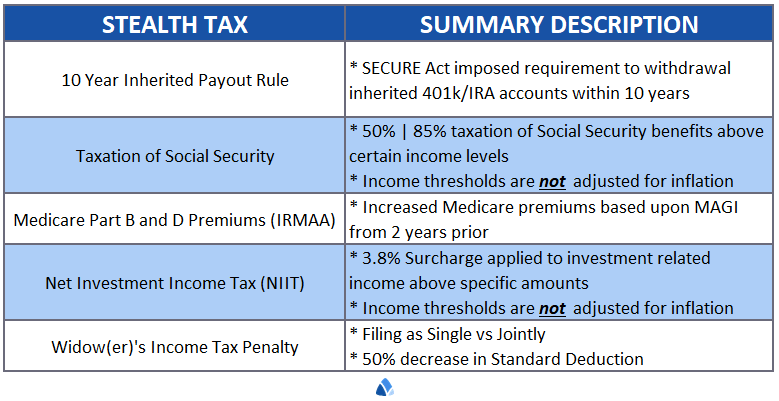5 Stealth Taxes That Can Impact Your Retirement
Jan 31, 2024 • Written by Paul Staib | Certified Financial Planner (CFP®), MBA, RICP®
Blog Home » Tax Planning » 5 Stealth Taxes That Can Impact Your Retirement

Every year, an increasing number of retirees are impacted by one or more “stealth” taxes. While certain taxes may be inevitable, effective long-term retirement planning can assist in lessening, minimizing, or even avoiding them altogether. This can lead to a reduction in your lifetime tax burden and may likely also benefit your heirs. Although several stealth taxes may not kick in until retirement, planning for each of them should begin long before and continue throughout retirement.
What is a “Stealth” Tax?
A stealth tax refers to a type of tax that is imposed indirectly or covertly, often without the taxpayer’s knowledge or awareness. Unlike traditional taxes which are more commonly known and understood, stealth taxes are often triggered once income exceeds certain levels, making them less noticeable to the average taxpayer.
Why Is This Important?
A common goal of retirement income planning is to optimize the longevity of your after-tax retirement income to pay for your projected inflation-adjusted expenses. In addition to having adequate retirement assets, there are two ways to achieve this goal: (a) maximize income and (b) minimize income tax liability. Stealth taxes increase your income tax liability, reducing your lifetime after-tax income.
Here are 5 Stealth Taxes:

Stealth Tax #1: 10-Year Payout Rule
The 10-year payout rule was created by the SECURE Act and is generally effective for deaths after December 31, 2019. It applies to most beneficiaries of retirement plans and IRA accounts. Under the new law, non-spouse beneficiaries (with few exceptions) must now withdraw the entirety of an inherited IRA within 10 years of the account owner’s passing rather than over their own lifetimes.
There are two potential types of stealth taxes that have been created by the 10-year payout rule.
- The first type of stealth tax is in the form of accelerated and potentially increased income tax liability compared to the tax liability created by the RMD rules. Having to deplete the account in 10 years will invariably result in beneficiaries being forced into higher tax brackets as they take the required withdrawals.
- The second type of stealth tax assessed by the IRS is an “excess accumulation” tax of 25% on the balance of funds remaining in any qualified retirement plan or IRA account at the end of the 10th year following the year of death of the qualified retirement plan participant or IRA owner. This is a penalty for anyone not following the new rule.
Stealth Tax #2: Taxation of Social Security Retirement Benefits
Taxation of Social Security benefits, which began in 1984, is one of the stealth taxes that is difficult to avoid due to its low-income threshold. The threshold, which is referred to as “provisional income,” is the total of adjusted gross income, nontaxable interest, and 50% of your Social Security benefits.
Single individuals with provisional income of $25,000 to $34,000 are taxed on up to 50% of benefits, and up to 85% on amounts above $34,000. Joint return filers with provisional income of $32,000 to $44,000 are taxed on up to 50% of benefits, and up to 85% on amounts exceeding $44,000. Unlike other income-sensitive thresholds, Social Security provisional income amounts have never been adjusted for inflation in 40 years, resulting in an increased number of individuals being subject to it each year.
Taxation of Social Security benefits is often a double stealth tax, as it may trigger other stealth taxes. The inclusion of up to 85% of benefits in taxable income, in addition to potentially increasing tax liability, can also increase marginal and long-term capital gains tax rates. Other potential fallouts include increased Medicare Part B and D premiums (IRMAA), increased exposure to net investment income tax (NIIT), and increased widow/widower’s income tax.
Stealth Tax #3: Increased Medicare Part B and D Premiums (IRMAA)
Medicare Part B and D premiums are determined using modified adjusted gross income (MAGI) from your federal income tax return two years prior to the current year.
In 2024, monthly premiums begin at $174.70. An Income Related Monthly Adjustment Amount (IRMAA) is added to this amount if your income is greater than $103,000 for single taxpayers and $206,000 for joint tax filers. Monthly premiums can be as high as $504.90 for those in the top income threshold, resulting in increased annual Medicare premiums of as much as $5,034 per person or $10,068 per couple.
Medicare Part B and Part D monthly premiums can increase significantly in a particular year because of an unusually large amount of income two years prior to the current year. This can include taxable gains from the sale of a residence or rental property or income resulting from a Roth IRA conversion.
Stealth Tax #4: Net Investment Income Tax (NIIT)
The net investment income tax (NIIT) is a surtax (equal to 3.8%) that Congress enacted in 2013 to help fund the Affordable Care Act. The tax is a surtax that is generally paid by high income taxpayers with significant investment income. This includes capital gains, interest, dividends, rental income, royalties, and nonqualified annuity income. The net investment income tax effectively increases the 15% and 20% long-term capital gains tax rate by 3.8% for higher income taxpayers.
The NIIT surtax applies if an individual’s modified adjusted gross income (MAGI) is above $200,000 for single filers or $250,000 for married couples filing jointly. NIIT is affecting an increasing number of taxpayers each year, as the income thresholds are not adjusted for inflation.
Stealth Tax #5: Widow(er)’s Income Tax Penalty
The widow(er)’s income tax may be the stealthiest of all stealth taxes since most people aren’t aware of it, it’s the most difficult to plan for, and it can potentially significantly increase a widow(er)’s federal and state tax liability each year once it starts.
Unfortunately, income tax law is not kind to a surviving spouse, particularly in the year following the year of death. A widow(er) who has the same, or even less, income than the married couple enjoyed will often be subject to higher federal, and potentially, state, income taxes.
This results from the transition from the use of married filing joint tax rates to single tax rates and a standard deduction of 50% of the married filing joint amount beginning in the year following the year of death of one’s spouse.
Stealth Tax Planning Opportunity: Strategic Roth IRA Conversions
Although there are various retirement income planning strategies that can be implemented to address each of the stealth taxes discussed in this article, there is one strategy that can reduce income tax liability attributable to them: a strategic multi-year Roth IRA conversion plan.
The current low historic income tax rates that are scheduled to expire after 2025 provide a window of opportunity for Roth IRA conversions that many of us may never see again in our lifetime. If you’re in your 50’s or 60’s and you have traditional 401(k) plans, SEP-IRAs, and traditional IRAs, why wait until RMD age when the value of your plans has potentially doubled, and tax rates are potentially higher to pay income tax on your distributions?
When you do a Roth IRA conversion, or a series of Roth IRA conversions using a strategic Roth IRA conversion plan, you eliminate taxation on the future growth of converted assets, reduce required minimum distributions (RMDs), and reduce dependency on taxable assets in retirement. This, in turn, allows you to reduce your exposure to stealth taxes throughout your retirement years.
Take the Long-View When Planning for Retirement
The stealth taxes discussed in this article can impact the success of your retirement in various stages of your life beginning long before you retire and continuing throughout your retirement. It is in your best interest to plan for the long-term. While it is difficult, if not impossible, to predict future tax rates, it is better to err on the conservative side when planning for a long-term event like retirement that may not begin for a few years but may last several decades.
Furthermore, it is crucial to look beyond just tax rates to understand how stealth taxes can potentially impact your retirement. None of the current stealth taxes is likely to be eliminated since each is responsible for billions of dollars of annual tax revenue. On the contrary, additional stealth taxes may be imposed as part of future tax legislation based on historical precedent. This is likely when considering given the current federal deficit and the fact that stealth taxes are confusing and often fly under the radar of the individual taxpayer – hence their name.
Unplanned for, stealth taxes can increase your income tax liability and reduce your lifetime after-tax retirement income. A couple of these tax conditions are difficult to avoid due to their low-income thresholds. Although several stealth taxes may not kick in until retirement, planning for each of them should begin long before and continue throughout retirement.

Paul Staib | Certified Financial Planner (CFP®), MBA, RICP®
Paul Staib, Certified Financial Planner (CFP®), RICP®, is an independent Flat Fee-Only financial planner. Staib Financial Planning, LLC provides comprehensive financial planning, retirement planning, and investment management services to help clients in all financial situations achieve their personal financial goals. Staib Financial Planning, LLC serves clients as a fiduciary and never earns a commission of any kind. Our offices are located in the south Denver metro area, enabling us to conveniently serve clients in Highlands Ranch, Littleton, Lone Tree, Aurora, Parker, Denver Tech Center, Centennial, Castle Pines and surrounding communities. We also offer our services virtually.
Read Next
Market Volatility: What should I do now?
• Written By Paul Staib | Certified Financial Planner (CFP®), MBA, RICP®
Stock markets have been choppy lately, pressured by all sorts of concerns – including tighter monetary policy, the impact of…
2016 Year End Tax Tips
• Written By Paul Staib | Certified Financial Planner (CFP®), MBA, RICP®
If tax time brings you stress, read on. First, take heart that you can act before the end of the…
